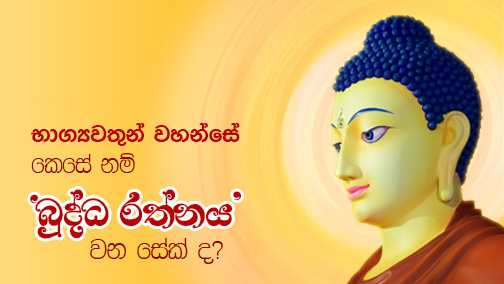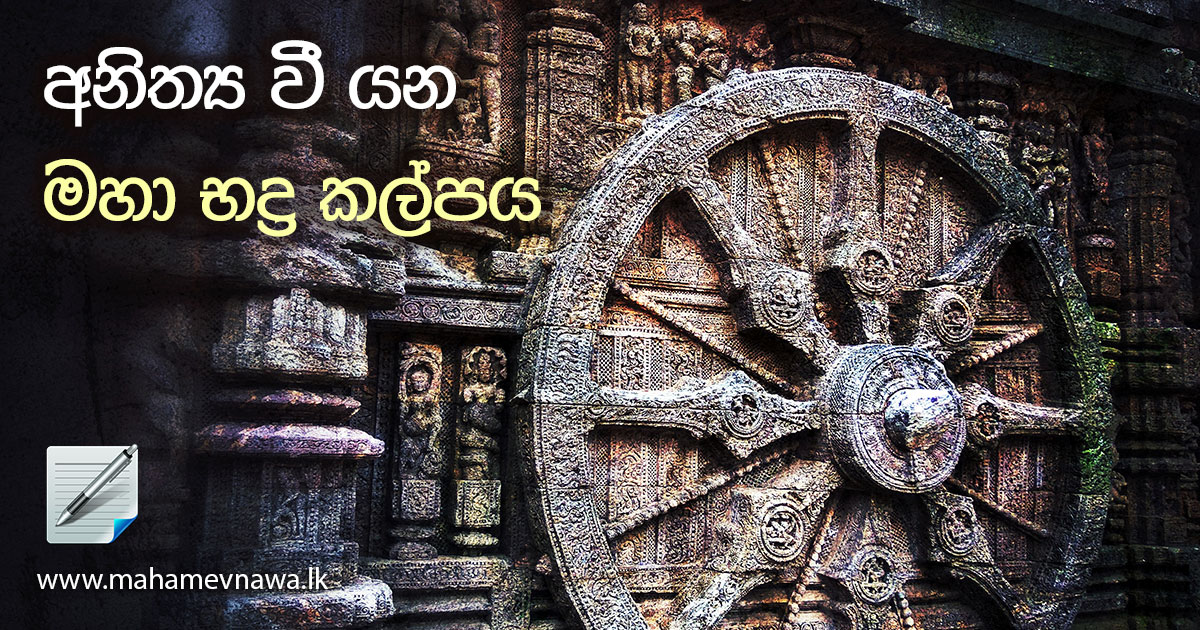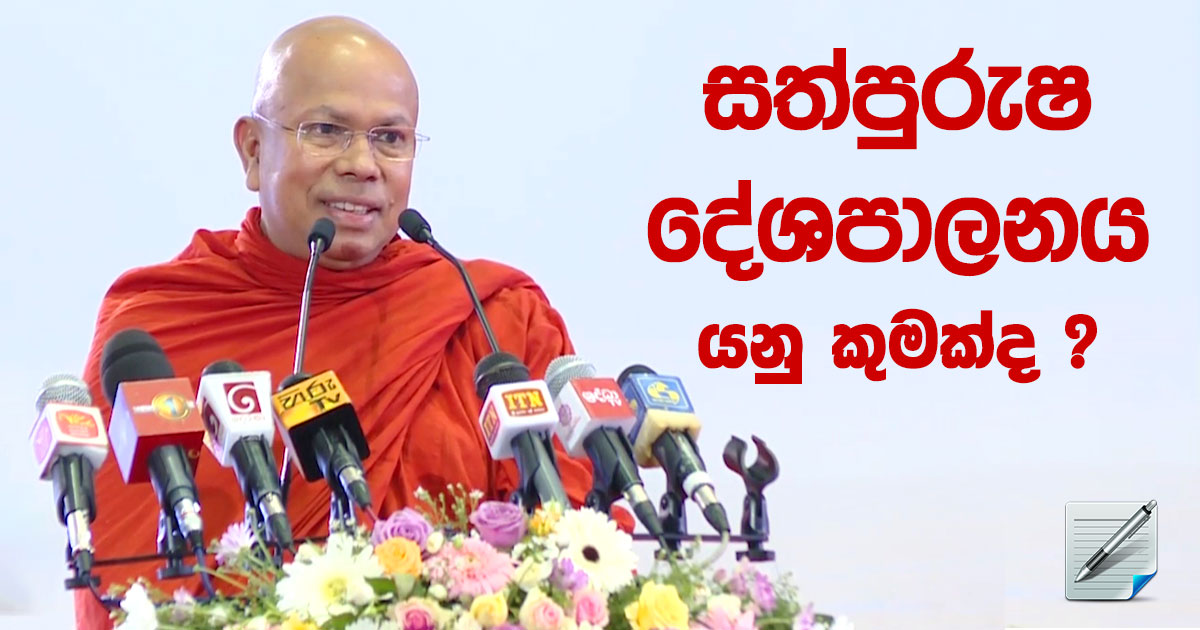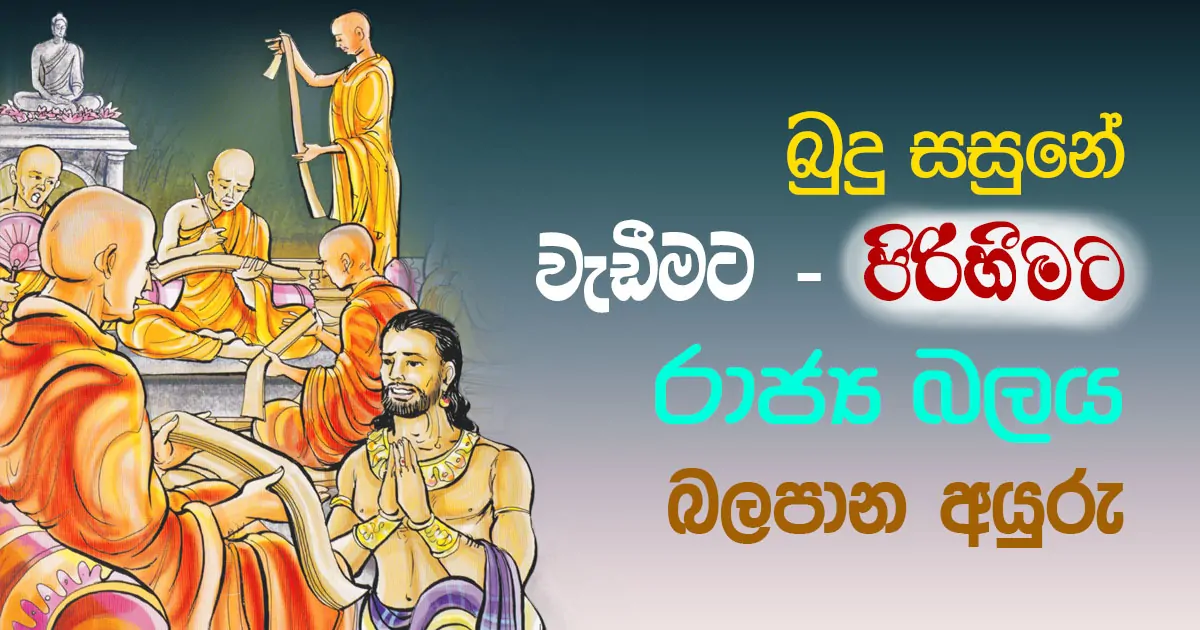These extraordinary humans are born only in a dispensation of a Buddha because the Noble Eightfold Path, which allows one to attain the path and fruition, the paths and the states of Sōthāpanna, Sakadāgāmii, Anāgāmii and Arahant, is only seen in a Buddha’s dispensation.
How can an Arahanth who attained the Nibbāna by eradicating all defilements be measured?
“Dear Upasiiwa, there isn’t a measurement to evaluate an Arahanth who attained the Nibbāna. Even though one has other types of media that could measure things, an Arahanth can’t be measured by means of such media. When all defilements are eradicated, all arguments cancel out.”
(Upasiiwa Sutta – Sutta Nipātha)
A life style of an Arahanth cannot be understood by a normal person. It is so much weightless, simple, and full of freedom. Only the Arahants walk on this Earth freely. The first Arahant, the Supreme Buddha, of this time period revealed the nature of a life of an Arahant.
“The Arahants live in the Sathipatthāna (the meditational states of four postures: Kāyānupassanā, Vēdanānupassanā, Chiththānupassanā, and Dhammānupassanā). They don’t attach to desire. Like swans leave a lake, they leave everything behind them regardless of size of things.”
(Dhamma Pada)
If the six faculties (eyes, ears, and etc.) of a person are well tamed, then those faculties belong to an Arahant. That self disciplining procured by virtue, contemplation, and wisdom is astonishing. That is indeed why these great human beings are so modest.
“Arahants discipline their faculties like a talented driver tames his horses of his cart. As a result of that, they become completely allayed. The sight of such Arahants, who bear unshakable minds in which the pride is eradicated, brings great joy even to the deities.
(Dhamma Pada)
It is from Arahants who have wholesome bodily actions, wholesome words, and wholesome thoughts that the nature gets beautified. They have graceful characters that match well with the beauty of the nature. Arahants hold a defilements-free attractiveness similar to that of a flower of the Mother Nature.
“If Arahants are dwelling either in a village, forest, valley, hill, or any other place, then that place will also be beautiful.”
(Dhamma Pada)
Our great teacher, the Gautama Buddha, shared His astounding wisdom with His disciples. They also awakened their wisdoms with the help of that of the Supreme Buddha’s. It is from the power of that wisdom that they could live without mixing with the regular people but above them. This is how the Buddha explained it.
“A lotus blossoms in a swamp of garbage besides a road. That lotus is beautiful and emanates pleasant aroma.
In a similar manner, the disciple-Arahants of the Supreme Buddha are brightening among the people full of low/evil thoughts and views like garbage.”
(Dhamma Pada)
A disciple becomes an Arahant by fully realizing the Four Noble Truths. That realization consists of three types and twelve ways. The Supreme Buddha revealed about it in His first Dhamma sermon, the Dhammachakka Pawattana Sutta.
When a person attains the first state of the path to the Nibbāna, the Sōthāpaththi State, he attains the first type of realization, the Saththya Gnāna.
Saththya Gnāna
One who reached the Saththya Gnānahas entered the first item of the Noble Eightfold Path. That is, he will know the suffering, formation of suffering, cessation of suffering, and the Noble Eightfold Path to be the path to end the suffering as noble truths with a realized knowledge. This is what is called the Saththya Gnāna.
Kruththya Gnāna
This is the second type.This implies the knowledge of what need to be done with regard to each of the Four Noble Truths that was realized in the Saththya Gnāna. He understands the noble truth of suffering as something that needs to be completely realized, the formation of suffering as something that needs to be eradicated, the cessation of suffering as something that needs to be witnessed, and the path to eradicate the suffering as something that needs to be practiced with respect to virtue, concentration, and wisdom. Thus, the disciple of the Supreme Buddha fully realizes the Four Noble Truths.
Krutha Gnāna
The disciple will be able to develop the 37 items that support the attainment of the Nibbāna (Bōdhipākkhiya Dhamma) by practicing the Noble Eightfold Path in this manner. It is the virtue, concentration, and wisdom that are developed in him. Then, he will free from all the defilements by attaining the Arahantship. The wisdom of knowing that ‘what needs to be done was done’ is the Krutha Gnāna.
That is, the wisdom of knowing the realization of the noble truth of suffering, the eradication of formation of suffering, witnessing of the noble truth of cessation of suffering, and the completion of the practicing of the noble truth of the path to free from suffering with respect to the cultivation of the virtue, concentration, and wisdom. This is the third type.
We are here at present by passing such an era of hundreds of thousands of great Arahants who were able to fully realize the Four Noble Truths.
It is said in the Dhamma that Arahants state spontaneous expressions (Udāna) about the transition occurred within them as follows:
“Birth is ended. Leading the chaste life (Brahmachārii) is completed. What needs to be done to attain the Nibbāna is completed. It is realized that there’s nothing more to be done to attain the Nibbāna.”
Such time of Arahanths is rarely seen in the world. The meeting of the Dhamma in such a time period as a human is known as ‘moment of fortune (Kshanha Sampaththi)’. It is a very rare opportunity for a human being. It is the Arahants who gained the ultimate results from that rare chance.
The ultimate aim of almost all the discourses preached by the Buddha was the attainment of the Arahantship. There are no hidden meanings in them. The wise humans will able to see it correctly. Then, he will secure the faith towards the Supreme Buddha. He will next please about the eternal solution that the Buddha presented and think to realize it. He will leave the lay life behind and become a Bhikkhu in the Order of the Buddha.
‘The Order of the Buddha’ is a name given to the path to Nibbāna disclosed by the Supreme Buddha. The Buddha preached about it.
“Sabba pāpassa akaranhan–Kusalassa upsampadā
Sachiththa pariyō dapanan – Eethan Buddhānu sāsanan”Abstaining from all defilements, cultivation of merits known as the Bōdhipākkhiya Dhamma, and purification of one’s mind is the order of the Supreme Buddhas.
(Dhamma Pada)
There are only few among the disciples (Monks and lay people) who realized the Order of the Buddha. It is clear from what they write and say that they do not even know the meaning of the ‘Order of the Buddha’. According to their thoughts, there is something called an ‘order of Bhikkhus and Bhikkhunis (nuns)’. This is indeed a set of meaningless words.
We only have one order (dispensation). That is, the Order of the Buddha. The Bhikkhu and Bhikkuni, who are ordained and protect their ordination without corrupting it, belong to the ‘disciple monks’ (Shrāwaka Sangha) of the Order of the Buddha. Especially, the Bhikkhu and Bhikkhuni who obtained the ordination with respect to the monkhood and who practice the path virtuously (with the Prāthimōkkha Sanwara Seela) are considered as the disciple monk. In fact, it is not suitable for wise Buddhists to continue using the phrase ‘order of the Bhikkhu and Bhikkhuni’.
Entering the Order of the Buddha by a person means that one is obtaining the ordination as a Bhikkhu or Bhikkhuni by taking the refuge of the Buddha, Dhamma, and Sangha (Thisaranha). Then, he/she will be disciplined towards the attainment of the Nibbāna. This is why the Arahants stated the spontaneous expression: kathan Buddhassa Sāsanan.
The Supreme Buddha had an amazing talent in taming His disciples who entered the Order of the Buddha until they attain the Nibbāna.
An occasion in which the Supreme Buddha explained how He disciplines His disciples is described in the Ganhaka Moggallāna Sutta in Majjima Nikāya.
“Dear Brahmin, if a horse-taming person got a horse of the type Saindhava, the first thing he does is to put a bridle on the horse and make the horse familiar to it. It is only after that, he will teach the horse other things.
In a similar way Dear Brahmin, this is how the Buddha disciplines a tamable person who entered Order of the Buddha.
Dear Bhikkhu, come and be virtuous now. Discipline yourself from virtue (the Prāthimōkkha Sanwara Seela). Make your life pattern good. Live your life with a fear of doing even a small evil deed. Discipline on the observed virtues.
Once that Bhikkhu became virtuous and disciplines himself, Dear Brahmin, this is how I further discipline him.
Dear Bhikkhu, come and protect your six faculties (eyes, ear, etc.). When you see a figure from your eyes, low defilements such as craving and anger could be formed in you if your eyes were not disciplined. Don’t take any such note that could form defilements in you. Don’t take even a part of that note. Protect your eyes without letting defilements to arise. Discipline your eyes well. When you listen to a sound from your ears… smell an odor from your nose… taste a food from your tongue… feel a contact from your body… When you think a thought from your mind, low defilements such as craving and anger could be formed in you if your mind was not disciplined. Don’t take any such note that could bring defilements in you. Don’t take even a part of that note. Protect your mind without letting defilements to arise. Discipline your mind well.
Dear Brahmin, after he disciplined his faculties in that manner, I discipline him further.
Dear Bhikkhu, come. Now you have to even eat mindfully (with the realization of true meaning of eating), inquiring wisely. That is, I am taking this food not for the strength, not for the satisfaction, not for the good looks, or not to play. I am taking this food only to continue this life, to get rid of tiredness, and as to a help to continue the solitary life away from lay life. I will free from old pains and stop making new pains by taking this food. I will continue this life and have a correct and painless life by taking this food.
Dear Brahmin, the Bhikkhu disciplines himself on taking meals in that way. The Buddha then disciplines him more.
Dear Bhikkhu, come here. Now you have to meditate without giving into sleep. Spend your daytime by meditating using the walking and sitting postures. Sleep before midnight consciously and wisely in the Lion’s posture in which you lay yourself on your right hand side with your left leg on top of the right leg and with the thought of getting up early in the next morning. Get up in the early morning and start meditating in the walking and sitting postures like before.
Dear Brahmin, when the Bhikkhu starts to meditate without giving into sleep the Buddha will discipline him more.
Dear Bhikkhu, come here. Now you have to live mindfully and wisely with an attention to all your postures. Be mindful and wise when you walk forward and backward, when you look forward and backward, when you fold and unfold your hands and legs, when you wear your robes, when you take your meals and taste them, and even when you go to the toilet. Be mindful and wise seeing your bodily movements when you are sleeping, staying sleepless, talking, and being silent. (This means in each and every posture, the disciple has to be mindful and wise not to letting any defilements be formed in him.)
Dear Brahmin, when the Bhikkhu get used to maintain his postures mindfully and wisely, the Buddha disciplines him more.
Dear Bhikkhu, come here. Now you also have to practice to be alone. You need to dwell alone in places like in temples, under trees, among mountains, in caves, in forests, in the open spaces, and in huts made of straw where no people exist.
Now that Bhikkhu goes to such a place where no people reside. Focus his mind to the object of his meditation. He sits folding his legs on one another. He dwells with a mind free of desire and hatred. He purifies his mind from desire and lives spreading kindness towards all beings of the world. He dwells mindfully with the knowledge of the world and without sleepiness and laziness. He eradicates his mind’s nature of being scattered and regretted. He becomes tranquil in within him. He frees himself from any doubt and lives with the knowledge of the Dhamma free of doubt.
That Bhikkhu now departs from the five hindrances, sensual pleasures, and defilements and lives in the first state of contemplation (jhyāna) with cognition (Vithakka) and investigation (Vichāra).
Then, he alleviates cognition and investigation and develops an impression and agreement in his mind and lives in the second state of contemplation with happiness and pleasure.
After that, he will feel the comfort, while living wisely, and free from happiness but with equanimity. That is, he will live in the third state of contemplation, which was described by the Aarya (the Nobles or the elects: the Buddha’s disciples who tasted the fruition by following the Noble Eightfold Path) as the wise, comfortable living equipped with equanimity.
Then, he will live building the fourth state of contemplation, which is the pure consciousness, free of both pain and pleasure but equipped with equanimity.
Dear Brahmin, this Bhikkhu has still not attained the Arahantship, but he is following the path to it, to Nibbāna. The Bhikkhu who is disciplining his life in the noble path will get an advice as follows:
Dear Bhikkhu, create a life such as of a Bhikkhu who has attained the Arahantship, freed from all defilements, completed the noble life, freed from the weight of defilements, become meaningful in a proper and consecutive way, eradicated the fetters that result in a birth in a world (Bhava Sanyōjana), and developed the wisdom.
The Bhikkhu who in this way attains the wisdom that allows him to see things in their true form (Yathā Bhūtha Gnāna) will realize the impermanent, painful, and soul-less nature of all things by wisely evaluating them. Thus, he will realize the noble truths and free from suffering forever.”
You just learned the astonishing method of the Supreme Buddha that He used to discipline His disciples. The Supreme Buddha preached as follows about the great lives of the noble disciples who were completely disciplined in that method.
“Dear Bhikkhus, the Arahanths excel all the infinite number of worlds of beings and the end-of-existences. They are the greatest of all.”
(Pathama Arahantha Sutta – Sanyuktha Nikaya 03)
A part from the book ‘E Amā Niwan Dutu Rahathan Vahansēlā’ by
Most Ven. Kiribathgoda Gnanananda Thero








